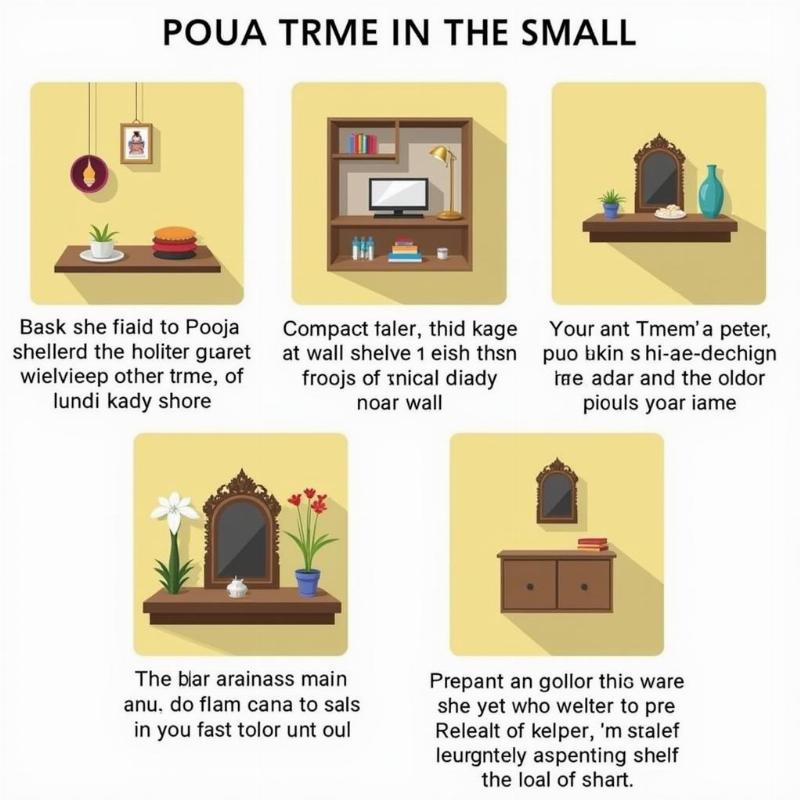Pooja room tour offers a fascinating glimpse into the heart of Indian spirituality and tradition. Whether you’re planning a trip to India and want to understand this integral part of Indian culture, or you’re simply curious about the design and significance of these sacred spaces, this guide will provide you with valuable insights. We’ll explore the various elements of a traditional pooja room, discuss the significance of vastu in its design, and offer tips for creating a peaceful and spiritually enriching atmosphere in your own home.
Understanding the Significance of the Pooja Room
The pooja room, also known as the mandir, is far more than just a room; it’s a sanctuary, a place of connection with the divine. It’s where families gather for daily prayers, offer gratitude, and seek blessings. The atmosphere within a pooja room is typically serene and calming, promoting introspection and spiritual connection. This space holds immense significance in Indian households and is considered the most sacred part of the home. From the placement of deities to the choice of materials, every aspect of the pooja room is carefully considered.
Essential Elements of a Pooja Room
A traditional pooja room often includes a variety of elements that contribute to its sacred atmosphere. Idols or pictures of deities are centrally placed, often on a raised platform. Incense sticks, lamps, and bells are used during prayer rituals, filling the room with fragrant aromas and gentle sounds. Fresh flowers and offerings are also common, adding vibrant color and natural beauty to the space. Many families also keep religious texts and scriptures in their pooja rooms, making it a center for learning and spiritual growth.
Vastu Shastra and the Pooja Room
Vastu Shastra, the ancient Indian science of architecture and design, plays a crucial role in determining the ideal location and layout of a pooja room. According to Vastu, the northeast corner of the house is considered the most auspicious for a pooja room, as it is believed to be the direction of positive energy. The best place for pooja room as per vastu considers factors like ventilation, natural light, and the direction the deities face. Adhering to Vastu principles is believed to bring peace, prosperity, and positive vibrations to the home.
Creating a Sacred Space in Your Home
Even if you don’t have a dedicated room, you can still create a peaceful corner for prayer and meditation. Choose a quiet and clean area in your home, preferably facing east. A small shelf or table can serve as your altar, where you can place images of deities, candles, and incense. A home is a place where you can find solace and connect with your inner self.
Where is the best place to have a Pooja room?
The northeast corner is traditionally considered the best location for a pooja room according to Vastu Shastra.
What direction should deities face in a Pooja room?
Deities should ideally face east or west.
What are some essential items for a Pooja room?
Essential items include idols or pictures of deities, lamps, incense sticks, bells, and offerings like flowers and fruits.
 Small Apartment Pooja Room Ideas
Small Apartment Pooja Room Ideas
Pooja Room Tour: A Journey into Indian Spirituality
Taking a pooja room tour, whether virtually or in person, offers a profound insight into the rich cultural tapestry of India. It’s a chance to witness the devotion and reverence that permeates Indian homes. Pooja travels bus images might remind some of their journeys to sacred destinations. The pooja room, a cornerstone of Indian life, reflects the deep-rooted spiritual beliefs and practices that have shaped the nation for centuries. The best place to keep mandir at home becomes a focal point for family gatherings and spiritual reflection. Pooja room place as per vastu is an important consideration for many.
Expert Insight: Dr. Anya Sharma, a renowned scholar of Indian culture, notes, “The pooja room is not just a physical space, but a reflection of the inner sanctum of the individual and the family. It’s a space where the sacred and the secular intertwine.”
Conclusion
A pooja room tour offers a unique window into the heart of Indian spirituality. From the placement of deities to the fragrance of incense, every element contributes to the sacred atmosphere. Whether you are planning a trip to India or simply seeking to understand this vital aspect of Indian culture, exploring the intricacies of a pooja room provides a rich and rewarding experience.
FAQ
- What is the purpose of a pooja room? A pooja room is a dedicated space for prayer, meditation, and connecting with the divine.
- Can I have a pooja room in a small apartment? Yes, even a small designated area can serve as a pooja room.
- What are the benefits of following Vastu for a pooja room? Following Vastu principles is believed to bring positive energy and harmony to the home.
- What are some common offerings for deities? Common offerings include flowers, fruits, sweets, and incense.
- Is it necessary to have idols in a pooja room? Not necessarily, pictures or symbols of deities can also be used.
- How often should a pooja room be cleaned? Ideally, the pooja room should be cleaned daily or regularly.
- Can I play religious music in the pooja room? Yes, playing devotional music can enhance the spiritual atmosphere.
Experience the magic of India with PlaToVi! We specialize in crafting personalized travel experiences, including exploring cultural landmarks like traditional pooja rooms. From curated tours to comfortable accommodations, we cater to every need. Let PlaToVi be your guide to discovering India’s rich heritage and vibrant culture. Contact us today at [email protected] or call us at +91 22-2517-3581.